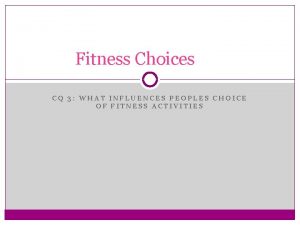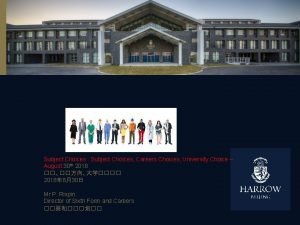Fitness Choices CQ 3 WHAT INFLUENCES PEOPLES CHOICE









- Slides: 9

Fitness Choices CQ 3: WHAT INFLUENCES PEOPLES CHOICE OF FITNESS ACTIVITIES

From the syllabus Learn About Learn to settings for exercise evaluate the appropriateness of -exercise at home, eg home gyms -community facilities -fitness centres and personal trainers -exercise clubs, eg running, walking, cycling -cultural groups fitness activities to them by investigating: - does this fitness activity suit my fitness needs? - could I continue to participate in this fitness activity? Why not? - are other fitness activities more suitable for me?

Settings for exercise The environments in which people exercise vary according to their fitness needs, facilities available and cost of activities. People do not have time or desire to go to a fitness centre may prefer to exercise at home In addition to fitness centres, many communities offer other sporting and recreational facilities. For those who prefer to exercise in groups, exercise clubs and cultural groups provide a range of physical activities

cont It is important that the setting chosen to exercise is in an enjoyable and convenient environment that meets the individual’s needs. If not, the likelihood of exercise continuing is reduced. .

Exercise at Home Exercise at home can be the most cost effective way to exercise. done with little or no equipment little or no cost. disadvantage is that the opportunity to tap into the expertise of others lost high level of motivation and commitment required to sustain Home gyms range from simple ones at a few hundred dollars to comprehensive ones costing tens of thousands The most popular home gym equipment is cardio based eg stationary bikes, treadmills and rowing machines. Dumbbells, barbells and multi-function weight machines are popular for strength-based training at home. A growing market exists for niche exercise aids, such as the abcruncher, which are advertised in infomercials and on. Often promising great results, many of these niche exercise aids develop only a limited range of fitness.

Community Facilities Community facilities play a significant role in providing equitable access to exercise facilities eg, halls, parks, tennis courts, golf clubs, walking tracks maintained by local councils. Community groups, charities and sporting associations also sometimes provide and/or maintain exercise facilities. The majority of costs associated with developing and maintaining community facilities are borne by the body that owns them, often the local council. income from the council rates paid by all local residents as well as government grants to meet the bulk of the costs.

Fitness centres and Personal Trainers Fitness centres can offer state-of-the-art facilities with highly credentialed trainers on site at your disposal. It can be expensive for fitness centres to provide this level of service and, therefore, the price of membership can also be expensive. Ultimately, the decision to join a centre is based around questions such as: Is this a preferred form of exercise for me? Can I afford it? Will I go regularly enough to get value for money? Are there any current or likely health issues that might restrict my capacity to go to the gym? Which fitness centre best meets my needs? Fitness centres clearly prefer to have people join as members, rather than pay to attend on a casual basis. As a result, annual membership fees (which are typically charged monthly or weekly) are cheaper than the cost of regular casual visits. It is quite common for a casual visit to a fitness centre to cost in excess of $25, while an annual membership fee can be less than $1000.

Exercise Clubs Exercise clubs are usually built around like-minded people joining to form a club based on a shared interest in a particular form of exercise eg running, swimming many exercise clubs have suffered a drop in membership people to want more flexibility and to feel less able to commit to the regular participation that clubs often require.

Cultural Groups sport and exercise have strong social and cultural factors underpinning them This can help to explain reasons behind participation as well as participation rates. Eg Australian climate and percentage of population who live near coast mean we have higher participation rates in water sports cultural approaches to exercise and sports participation continue when people migrate to Australia. E. g pacific Islander & rugby codes, while gymnastics participation rates are proportionally higher among people with eastern European backgrounds participating in forms of exercise and sport in Australia that are similar to those in the home country provides a feeling of connection
 What influences people’s choice of fitness activities?
What influences people’s choice of fitness activities? Physiological influences on food choices include
Physiological influences on food choices include Psychological influences on food choices
Psychological influences on food choices Influences on food choices worksheet
Influences on food choices worksheet Skill health related fitness
Skill health related fitness Good choice or bad choice
Good choice or bad choice The peoples of north america and mesoamerica
The peoples of north america and mesoamerica Clap your hands all ye peoples make a joyful noise
Clap your hands all ye peoples make a joyful noise Nomadic peoples who herded domesticated animals
Nomadic peoples who herded domesticated animals Peoples speke
Peoples speke

















